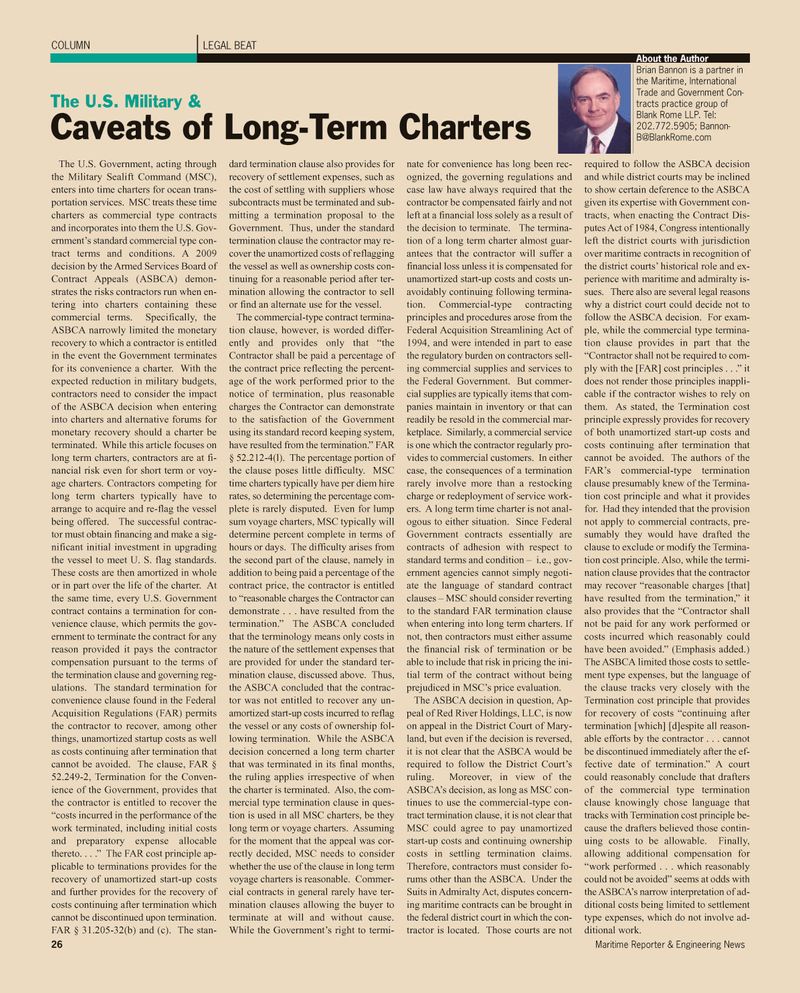
Page 26: of Maritime Reporter Magazine (March 2011)
Ship Repair & Conversion
Read this page in Pdf, Flash or Html5 edition of March 2011 Maritime Reporter Magazine
26 Maritime Reporter & Engineering News
COLUMN LEGAL BEAT
The U.S. Government, acting through the Military Sealift Command (MSC), enters into time charters for ocean trans- portation services. MSC treats these time charters as commercial type contracts and incorporates into them the U.S. Gov- ernment’s standard commercial type con- tract terms and conditions. A 2009 decision by the Armed Services Board of
Contract Appeals (ASBCA) demon- strates the risks contractors run when en- tering into charters containing these commercial terms. Specifically, the
ASBCA narrowly limited the monetary recovery to which a contractor is entitled in the event the Government terminates for its convenience a charter. With the expected reduction in military budgets, contractors need to consider the impact of the ASBCA decision when entering into charters and alternative forums for monetary recovery should a charter be terminated. While this article focuses on long term charters, contractors are at fi- nancial risk even for short term or voy- age charters. Contractors competing for long term charters typically have to arrange to acquire and re-flag the vessel being offered. The successful contrac- tor must obtain financing and make a sig- nificant initial investment in upgrading the vessel to meet U. S. flag standards.
These costs are then amortized in whole or in part over the life of the charter. At the same time, every U.S. Government contract contains a termination for con- venience clause, which permits the gov- ernment to terminate the contract for any reason provided it pays the contractor compensation pursuant to the terms of the termination clause and governing reg- ulations. The standard termination for convenience clause found in the Federal
Acquisition Regulations (FAR) permits the contractor to recover, among other things, unamortized startup costs as well as costs continuing after termination that cannot be avoided. The clause, FAR § 52.249-2, Termination for the Conven- ience of the Government, provides that the contractor is entitled to recover the “costs incurred in the performance of the work terminated, including initial costs and preparatory expense allocable thereto. . . .” The FAR cost principle ap- plicable to terminations provides for the recovery of unamortized start-up costs and further provides for the recovery of costs continuing after termination which cannot be discontinued upon termination.
FAR § 31.205-32(b) and (c). The stan- dard termination clause also provides for recovery of settlement expenses, such as the cost of settling with suppliers whose subcontracts must be terminated and sub- mitting a termination proposal to the
Government. Thus, under the standard termination clause the contractor may re- cover the unamortized costs of reflagging the vessel as well as ownership costs con- tinuing for a reasonable period after ter- mination allowing the contractor to sell or find an alternate use for the vessel.
The commercial-type contract termina- tion clause, however, is worded differ- ently and provides only that “the
Contractor shall be paid a percentage of the contract price reflecting the percent- age of the work performed prior to the notice of termination, plus reasonable charges the Contractor can demonstrate to the satisfaction of the Government using its standard record keeping system, have resulted from the termination.” FAR § 52.212-4(l). The percentage portion of the clause poses little difficulty. MSC time charters typically have per diem hire rates, so determining the percentage com- plete is rarely disputed. Even for lump sum voyage charters, MSC typically will determine percent complete in terms of hours or days. The difficulty arises from the second part of the clause, namely in addition to being paid a percentage of the contract price, the contractor is entitled to “reasonable charges the Contractor can demonstrate . . . have resulted from the termination.” The ASBCA concluded that the terminology means only costs in the nature of the settlement expenses that are provided for under the standard ter- mination clause, discussed above. Thus, the ASBCA concluded that the contrac- tor was not entitled to recover any un- amortized start-up costs incurred to reflag the vessel or any costs of ownership fol- lowing termination. While the ASBCA decision concerned a long term charter that was terminated in its final months, the ruling applies irrespective of when the charter is terminated. Also, the com- mercial type termination clause in ques- tion is used in all MSC charters, be they long term or voyage charters. Assuming for the moment that the appeal was cor- rectly decided, MSC needs to consider whether the use of the clause in long term voyage charters is reasonable. Commer- cial contracts in general rarely have ter- mination clauses allowing the buyer to terminate at will and without cause.
While the Government’s right to termi- nate for convenience has long been rec- ognized, the governing regulations and case law have always required that the contractor be compensated fairly and not left at a financial loss solely as a result of the decision to terminate. The termina- tion of a long term charter almost guar- antees that the contractor will suffer a financial loss unless it is compensated for unamortized start-up costs and costs un- avoidably continuing following termina- tion. Commercial-type contracting principles and procedures arose from the
Federal Acquisition Streamlining Act of 1994, and were intended in part to ease the regulatory burden on contractors sell- ing commercial supplies and services to the Federal Government. But commer- cial supplies are typically items that com- panies maintain in inventory or that can readily be resold in the commercial mar- ketplace. Similarly, a commercial service is one which the contractor regularly pro- vides to commercial customers. In either case, the consequences of a termination rarely involve more than a restocking charge or redeployment of service work- ers. A long term time charter is not anal- ogous to either situation. Since Federal
Government contracts essentially are contracts of adhesion with respect to standard terms and condition – i.e., gov- ernment agencies cannot simply negoti- ate the language of standard contract clauses – MSC should consider reverting to the standard FAR termination clause when entering into long term charters. If not, then contractors must either assume the financial risk of termination or be able to include that risk in pricing the ini- tial term of the contract without being prejudiced in MSC’s price evaluation.
The ASBCA decision in question, Ap- peal of Red River Holdings, LLC, is now on appeal in the District Court of Mary- land, but even if the decision is reversed, it is not clear that the ASBCA would be required to follow the District Court’s ruling. Moreover, in view of the
ASBCA’s decision, as long as MSC con- tinues to use the commercial-type con- tract termination clause, it is not clear that
MSC could agree to pay unamortized start-up costs and continuing ownership costs in settling termination claims.
Therefore, contractors must consider fo- rums other than the ASBCA. Under the
Suits in Admiralty Act, disputes concern- ing maritime contracts can be brought in the federal district court in which the con- tractor is located. Those courts are not required to follow the ASBCA decision and while district courts may be inclined to show certain deference to the ASBCA given its expertise with Government con- tracts, when enacting the Contract Dis- putes Act of 1984, Congress intentionally left the district courts with jurisdiction over maritime contracts in recognition of the district courts’ historical role and ex- perience with maritime and admiralty is- sues. There also are several legal reasons why a district court could decide not to follow the ASBCA decision. For exam- ple, while the commercial type termina- tion clause provides in part that the “Contractor shall not be required to com- ply with the [FAR] cost principles . . .” it does not render those principles inappli- cable if the contractor wishes to rely on them. As stated, the Termination cost principle expressly provides for recovery of both unamortized start-up costs and costs continuing after termination that cannot be avoided. The authors of the
FAR’s commercial-type termination clause presumably knew of the Termina- tion cost principle and what it provides for. Had they intended that the provision not apply to commercial contracts, pre- sumably they would have drafted the clause to exclude or modify the Termina- tion cost principle. Also, while the termi- nation clause provides that the contractor may recover “reasonable charges [that] have resulted from the termination,” it also provides that the “Contractor shall not be paid for any work performed or costs incurred which reasonably could have been avoided.” (Emphasis added.)
The ASBCA limited those costs to settle- ment type expenses, but the language of the clause tracks very closely with the
Termination cost principle that provides for recovery of costs “continuing after termination [which] [d]espite all reason- able efforts by the contractor . . . cannot be discontinued immediately after the ef- fective date of termination.” A court could reasonably conclude that drafters of the commercial type termination clause knowingly chose language that tracks with Termination cost principle be- cause the drafters believed those contin- uing costs to be allowable. Finally, allowing additional compensation for “work performed . . . which reasonably could not be avoided” seems at odds with the ASBCA’s narrow interpretation of ad- ditional costs being limited to settlement type expenses, which do not involve ad- ditional work.
The U.S. Military &
Caveats of Long-Term Charters
About the Author
Brian Bannon is a partner in the Maritime, International
Trade and Government Con- tracts practice group of
Blank Rome LLP. Tel: 202.772.5905; Bannon-

 25
25

 27
27
